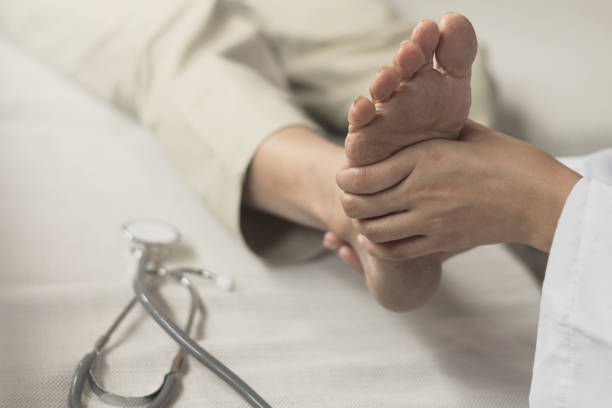Walking on rheumatoid arthritis feet is an indescribable, painful experience for those suffering from the disease. According to licensed chiropractor Tom Gehrmann, the prevention and cure for the rheumatoid disease should be given priority.
Rheumatoid is another form of arthritis and causes pain to the person experiencing it. It is a severe inflammatory pain that lasts for a long time. The pain normally comes from the joints of the person suffering from this disease. Rheumatoid is an example of an autoimmune disease that fights the body’s tissues. A person experiencing rheumatoid in the joints of a foot will feel that the foot is swollen. Furthermore, it feels painful to walk on that foot. This limits the patient’s locomotive movements.
Tom Gehrmann Colorado Springs says that researchers are still trying to find ways to alleviate rheumatoid pains and preventive measures to prevent rheumatoid. Some research supports medical care, while some supports using chiropractic methods to alleviate rheumatoid pains.
This is why Thomas Gehrmann used his decades of experience to tell us how to treat rheumatoid feet.
However, let’s first talk about how to identify if the pain you are feeling in your feet is rheumatoid pain.
How to Identify Rheumatoid Pain
Your feet have several joints, tissues, and bones. Any of these can be subjected to rheumatoid pain because your immune system can attack them. When this happens, your feet will cause you pain.
You may be experiencing starting symptoms like:
- Swollen feet
- The skin of your feet will turn red
- The skin of your feet feels warm when you touch it.
- You have difficulty walking around.
- You are unable to stand for a long time.
- You feel pain in your feet when you move about.
After a while, the disease becomes more severe. Then your feet will start to deform. You will experience symptoms like:
- Bunions: This is when the first toes of both feet shift in the direction of the second toes of both feet. Two painful bumps will form at the bottom of the first toes. The bumps are scientifically known as bunions.
- Flat arch: Rheumatoid damages your feet’s ligaments. When the disease becomes severe, you won’t be able to stand firmly with your feet. The arch of your feet will collapse and flattens. Then foot deformation occurs.
- Claw Toes: This is also an example of foot deformation. The little joints of the second, third, fourth, and fourth toes bend to form claws. A person experiencing claw feet finds it difficult to stand on both feet.
- Both feet will tingle due to damage to the nerves.
- It can cut off blood flow to the feet by damaging the blood vessels. When this occurs, your feet feel as if they are sleeping.
Things that trigger Rheumatoid:
- Inadequate sleep/rest
- Sickness
- When you are stressed
- Overworking to the point where you are exhausted
- Infections
- Incorrect intake of drugs/medications
How to Alleviate Rheumatoid Pain
There are many ways of alleviating rheumatoid pain. Some patients prefer going to a chiropractic doctor, while many prefer to go to a hospital.
In the medical field, some healthcare practitioners treat the immune systems of their rheumatoid patients. The treatment aims to slow down the system’s attack on the joints. While some specifically focus on and treat the patients’ feet.
These treatment methods are:
The use of medicines
Patients are given medicines to reduce the activities of the immune systems that attack the patients’ bodies. Gradually, the patient will feel fewer symptoms on both feet. However, rheumatoid medicines take a long time to work in the body.
Another type of medicine given to rheumatoid arthritis patients is anti-inflammatory drugs. This reduces inflammation that occurs when the pain is severe.
Natural/Home Remedy
People can use home remedies to alleviate rheumatoid arthritis pain.
These are home remedy tips:
- Do not overexert yourself: Do not overwork yourself or do activities that put pressure on your feet. If your job involves frequent walks, or you are always standing up, take the time to rest. Take breaks to rest your feet.
- Use supporting devices: If you experience constant pain as you walk, use a cane to support yourself. You can also opt for a walker if you prefer that. This also applies when you need to walk a long distance. Supporting yourself with a walker will reduce the pressure on your feet and decrease the pain.
- Put hot packs on both feet: Warm up both feet with heat packs. Another alternative is to soak both feet in lukewarm water for fifteen minutes. Remove both feet, then soak for another fifteen minutes. Continue to do so until you feel relieved from the pain. This will improve blood circulation to your feet and stimulate them.
- Gently exercise your feet: Make it a habit to often elevate your feet.
- Wear comfortable shoes: For ladies, avoid wearing high heel shoes because they put pressure on your arch and soles. Men should avoid wearing tight-fitted shoes. Wear shoes that make your feet comfortable.
Surgeries
In extreme circumstances like foot deformation, doctors recommend surgeries for rheumatoid patients.
Conclusion
“Having rheumatoid feet is not the end of the world,” says Tom Gehrmann. The medical field has advanced so much that there are now many ways to treat rheumatoid disease.
Visit a rheumatoid specialist at a healthcare center today to get the treatments you need. Rheumatoid patients can also consult physical therapists or chiropractic doctors.
Do not manage nor endure your pain.












